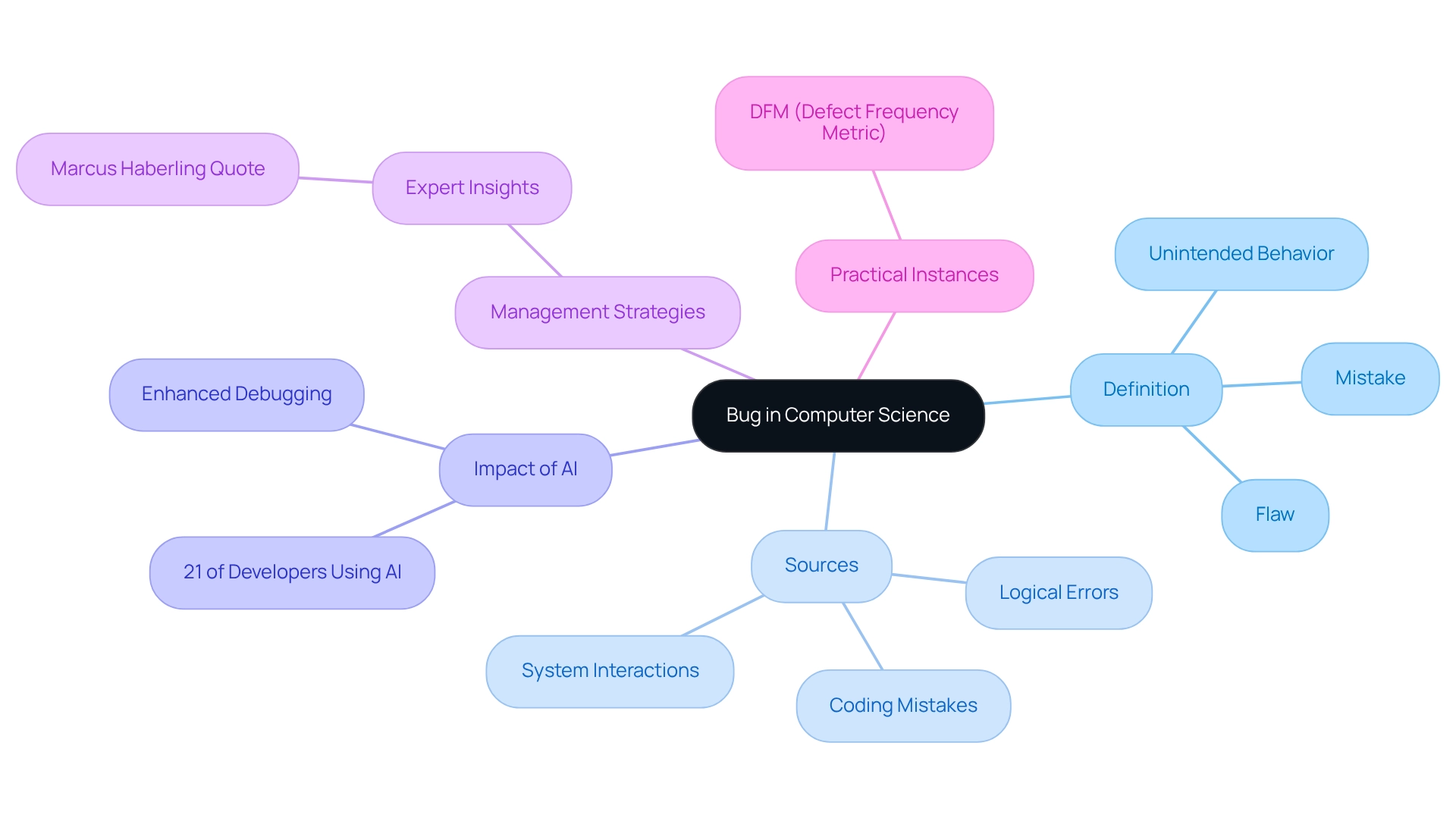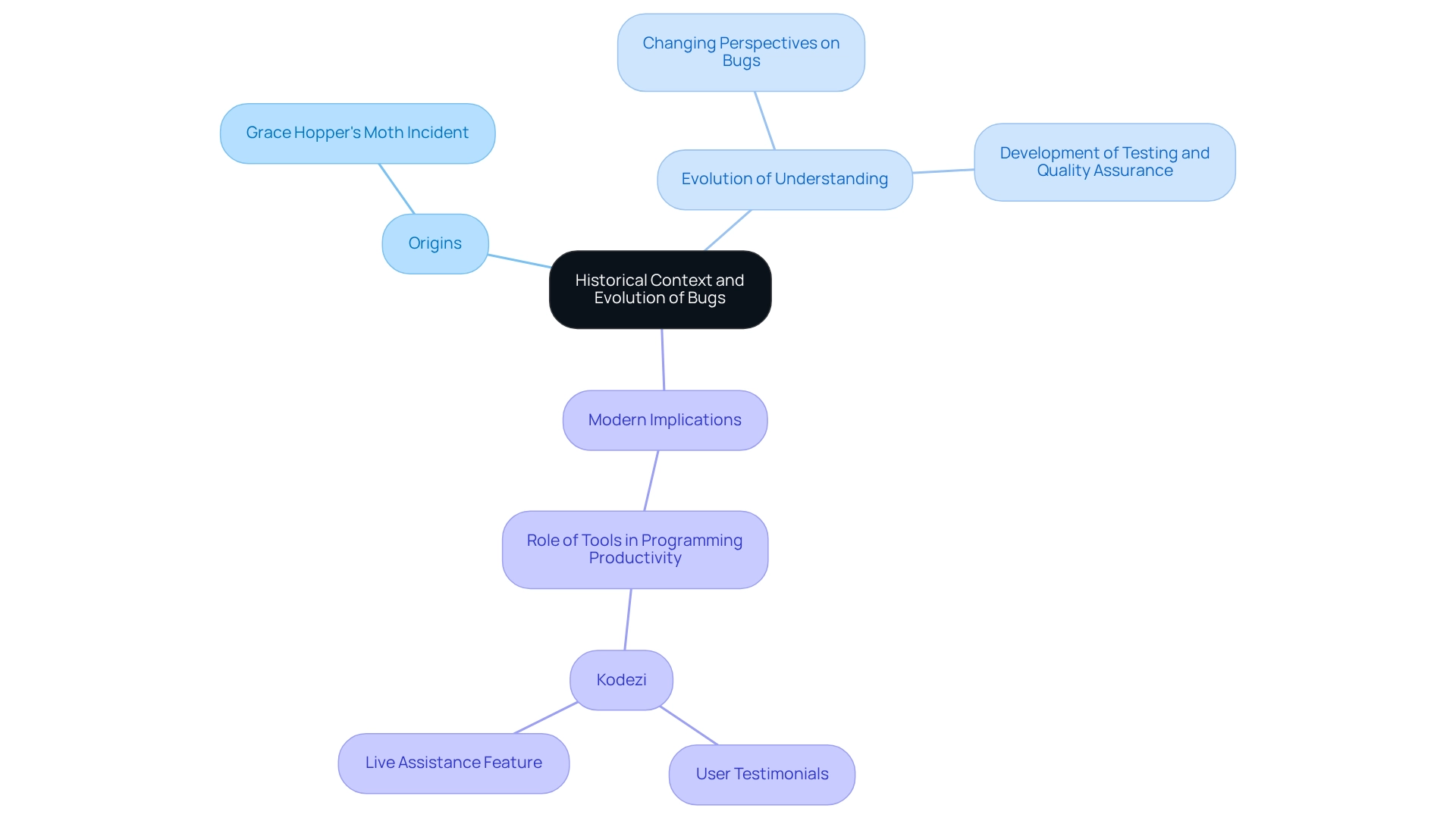Overview
In the realm of computer science, developers often encounter significant challenges due to bugs—mistakes or flaws in programs that lead to incorrect or unexpected behavior. These issues have historical roots, tracing back to anecdotes like Grace Hopper's famous discovery of a moth causing a malfunction in early computing. Understanding the various types of bugs—such as syntax, logic, runtime, and semantic errors—is crucial, as they directly affect software performance and user satisfaction.
So, how can developers effectively tackle these challenges? This is where Kodezi comes into play. With its powerful debugging tools and practices, Kodezi addresses the common pain points faced by developers, ensuring that coding becomes a smoother experience. By providing features designed specifically for identifying and resolving bugs, Kodezi enhances the overall development process.
The benefits of using Kodezi are clear: improved productivity and higher code quality. Imagine being able to catch errors early in the development cycle and streamline your workflow—this not only saves time but also boosts confidence in the final product. Furthermore, Kodezi empowers developers to focus on creating innovative solutions rather than getting bogged down by technical issues.
Are you ready to elevate your coding experience? Explore the tools available on the Kodezi platform and discover how they can transform your approach to software development. With Kodezi, tackling bugs becomes less of a chore and more of an opportunity for growth and efficiency.
Introduction
In the complex landscape of software development, coding challenges pose a significant hurdle that can disrupt functionality and diminish user experience.
Bugs, defined as errors or flaws within a program, can emerge from various sources, including coding mistakes and unforeseen interactions among components.
As technology advances, our understanding of bugs evolves, transforming them from mere nuisances into critical indicators of a system's overall health.
Furthermore, with the rise of advanced debugging tools and AI technologies, developers are now better equipped to address these challenges more efficiently than ever before.
This article explores the definition, historical context, and types of bugs, highlighting their implications for software quality and the innovative solutions available to enhance debugging practices.
How can tools like Kodezi help developers navigate these issues? By leveraging specific features designed to streamline debugging, Kodezi addresses the persistent challenges developers face, ultimately improving productivity and code quality.
Explore the tools available on the platform to see how they can make a difference in your development process.
Defining a Bug in Computer Science
In computer science, the definition of bug in computer is a mistake, flaw, or unintended behavior within a computer program that leads to incorrect or unexpected outcomes. Bugs can originate from various sources, including coding mistakes, logical errors, or unforeseen interactions among system components. While the terms 'bug,' 'defect,' and 'fault' are often used interchangeably, 'bug' specifically refers to issues that hinder the functionality or performance of applications.
Understanding the definition of bug in computer is crucial, as it directly impacts the quality and dependability of applications. Recent studies indicate that 21% of developers are leveraging AI tools, such as ChatGPT and GitHub Copilot, to assist in debugging. This highlights the growing reliance on technology to enhance the debugging process. These AI technologies not only anticipate frequent issues but also offer insights that allow developers to pinpoint root causes more effectively, ultimately enhancing overall application quality.
Practical instances of flaws can be observed in different applications, where even small mistakes can result in considerable performance problems. For example, a recent article highlighted that the DFM (Defect Frequency Metric) improves the capacity to diagnose and address technical issues swiftly. This emphasizes the significance of efficient bug management. As Marcus Haberling aptly stated, "You should try and keep their number down and deal with them opportunistically," underscoring the proactive approach needed in bug management.
In summary, a thorough comprehension of the definition of bug in computer programming errors is crucial for developers. It not only impacts the immediate functionality of applications but also has long-term effects on quality and user satisfaction.

Historical Context and Evolution of Bugs
Coding challenges are a common hurdle for developers, often leading to frustration and inefficiency. The definition of bug in computer science has its roots in the early days of computing, with one of the most notable anecdotes involving Grace Hopper, a trailblazing computer scientist. In 1947, Hopper and her team discovered a moth trapped in the Harvard Mark II computer, which was causing a malfunction. This event not only represented the first documented occurrence of a computer flaw but also made the term 'debugging' well-known in relation to the definition of bug in computer, referring to the process of identifying and correcting such problems.
As programming languages and development techniques advanced, so did the comprehension of flaws. Initially seen as uncommon irregularities, issues became acknowledged as a fundamental element of application development. This change in viewpoint resulted in the creation of strict testing and quality assurance methods focused on reducing their frequency and alleviating their effects. Furthermore, the development of issues has been recorded through multiple case studies, showing how the intricacy of technological systems has heightened the chances of problems.
Today, the definition of bug in computer programming is viewed not just as a nuisance but as a critical indicator of the need for continuous improvement in coding practices and software design. In this context, tools such as Kodezi, which secured $800k in a pre-seed round from Watertower Ventures and RTP Global, are leading the way in boosting programming productivity by decreasing error resolution time and simplifying codebases. The introduction of Kodezi Live Assistance has enabled over 1,000,000 users to troubleshoot code more efficiently, transforming the troubleshooting experience. User testimonials reinforce Kodezi's effectiveness in improving debugging and programming productivity, highlighting the essential role of effective debugging tools for modern developers.
What if you could reduce the time spent on debugging? Kodezi not only addresses these challenges but also enhances productivity and code quality. By utilizing Kodezi, developers can streamline their coding processes and focus on what truly matters—creating innovative software solutions. Explore the tools available on the Kodezi platform and experience the difference in your coding journey.

Types of Bugs and Their Implications
The definition of bug in computer refers to errors that can significantly impact software performance and user experience, presenting various challenges for developers. Understanding the definition of bug in computer and the different types of bugs is essential for efficient problem-solving. The most common categories include:
- Syntax Errors: These mistakes violate the rules of the programming language, preventing the program from compiling or running. Although syntax issues are often the simplest to spot and resolve, they can delay development if not addressed promptly. Tools like Kodezi CLI can autonomously identify and rectify these issues, ensuring a smoother development process with detailed insights into the corrections made.
- Logic Errors: These flaws occur in the program's logic, leading to incorrect results even when the code runs without crashing. Logic errors can be particularly deceptive, as they may not surface until certain conditions are met, making them more difficult to identify and fix. Kodezi's automated debugging features provide comprehensive insights into these issues, facilitating quicker resolutions and enhancing overall code quality.
- Runtime Issues: These problems arise during program execution, often due to invalid operations, such as division by zero. Runtime issues can cause programs to crash or behave unpredictably, adversely affecting user experience and system reliability. Kodezi CLI aids in swiftly detecting and resolving such runtime problems, boosting overall program stability.
- Semantic Issues: These occur when the code runs without faults but produces unintended results due to incorrect assumptions about the problem domain. Semantic issues can lead to significant discrepancies between expected and actual outcomes, complicating troubleshooting efforts. Kodezi's AI-driven analysis helps developers identify these mistakes early in the development cycle, offering insights into their root causes, highlighting the importance of the definition of bug in computer systems, as each type of bug can influence application functionality, user satisfaction, and overall system integrity differently. Developers must comprehend the definition of bug in computer to address issues efficiently, ensuring high-quality delivery. For instance, Launchable provides profound insights into test performance, demonstrating how maintaining communication through tools like Slack can keep teams informed about critical alerts regarding unsuccessful tests. This ultimately enhances their responsiveness to issues. As the software development landscape evolves, recognizing and addressing the implications of various types of bugs is crucial for preserving code integrity and ensuring user satisfaction.

Conclusion
Understanding the multifaceted nature of software bugs is crucial for developers striving to enhance functionality and user experience. Bugs, ranging from syntax and logic errors to more complex semantic issues, can severely impact software performance if not addressed promptly. The historical context provided by figures like Grace Hopper underscores the evolution of bug management from a simplistic view to a vital aspect of modern software development.
As technology progresses, so too do the tools available to developers. Innovations such as Kodezi not only streamline the debugging process but also empower developers to tackle challenges more efficiently. The integration of AI-driven solutions allows for quicker identification of bugs, ultimately improving code quality and reducing the time spent on debugging.
In conclusion, the proactive management of software bugs is essential for maintaining high standards of software quality. By leveraging advanced tools and understanding the implications of various types of bugs, developers can enhance their productivity and deliver superior user experiences. Embracing these practices not only safeguards the integrity of software applications but also fosters a culture of continuous improvement in the ever-evolving landscape of technology.
Frequently Asked Questions
What is the definition of a bug in computer science?
A bug in computer science is a mistake, flaw, or unintended behavior within a computer program that leads to incorrect or unexpected outcomes.
What are some common sources of bugs?
Bugs can originate from various sources, including coding mistakes, logical errors, or unforeseen interactions among system components.
How are the terms 'bug,' 'defect,' and 'fault' related?
While 'bug,' 'defect,' and 'fault' are often used interchangeably, 'bug' specifically refers to issues that hinder the functionality or performance of applications.
Why is understanding bugs important for developers?
Understanding the definition of a bug is crucial as it directly impacts the quality and dependability of applications.
How are developers using AI tools in relation to bugs?
Recent studies indicate that 21% of developers are leveraging AI tools, such as ChatGPT and GitHub Copilot, to assist in debugging, enhancing the debugging process and helping to pinpoint root causes more effectively.
What is the DFM (Defect Frequency Metric) and its significance?
The DFM improves the capacity to diagnose and address technical issues swiftly, emphasizing the significance of efficient bug management.
What approach is suggested for managing bugs?
A proactive approach is recommended for bug management, as highlighted by Marcus Haberling, who stated, 'You should try and keep their number down and deal with them opportunistically.'
What are the long-term effects of bugs on applications?
Bugs not only impact the immediate functionality of applications but also have long-term effects on quality and user satisfaction.




